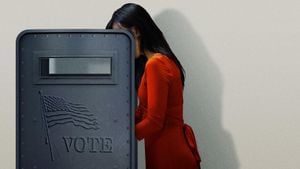Former President Donald Trump has solidified his status once again as the leading figure among Indiana voters, winning the state decisively in the 2024 presidential election. According to projections from major networks, Trump secured around 59% of the votes against Vice President Kamala Harris, who garnered about 40%. The Associated Press made the call shortly after the polls closed at 7 p.m., marking another victory for Trump, who has now carried Indiana three consecutive times since he first ran for office.
Indiana, known for its conservative leanings, contributed 11 electoral votes to Trump’s tally, reaffirming its reputation as a reliably red state. The last time Indiana backed a Democrat for president was back in 2008 when Barack Obama narrowly won the state. Since then, Indiana has trended firmly Republican, with Trump also winning the state by wide margins against opponents Hillary Clinton and Joe Biden.
The turnout for this year’s presidential race was significant, with approximately 4.8 million registered voters casting their ballots. This election also marked the implementation of new voter ID laws, which were passed by Indiana’s Republican legislature earlier this year. The regulations tightened mail-in voting requirements and required first-time voters to show proof of residency when registering. Such legislative moves were part of broader national conversations about election integrity and access, echoing sentiments from previous election cycles.
"For the third time, Indiana is among the first states on the board for President Trump," stated Indiana GOP Chairman Randy Head. He emphasized the party's confidence and momentum following the results. Trump first won Indiana's electoral votes back in 2016 against Clinton and solidified his hold on the state by outperforming expectations again during the 2020 election against Biden.
Meanwhile, Harris’s campaign faced turbulence as they attempted to sway voters amid the changing dynamics of Indiana's electoral behavior. The Vice President did make efforts to reach voters, including addressing members of the historically Black sorority Zeta Phi Beta during the summer. Yet, neither national candidate campaigned extensively within the state during the lead-up to this election.
Looking back, Trump’s popularity among Indiana voters has continued to grow, as evident from earlier primaries where he dominated with 78% of the votes compared to challengers, such as Nikki Haley, who received just under 22%. This established base of support extended through to this presidential election, as polls indicated Trump was leading by substantial margins, with Emerson College polling from September showing him up by 17 points.
Another interesting dynamic to note was fundraising efforts within the Hoosier State. Harris, who raised over $5 million from Indiana donors, slightly edged out Trump’s $4.7 million haul. Those financial metrics paint a fascinating picture of the competitive nature of this election, even within unequivocally Republican demographics.
Despite this outcome, experts suggest the decision made by Hoosier voters is unlikely to sway the overall election outcome, as attention pivots toward more competitive battleground states where elections are expected to be tightly contested. States such as Pennsylvania and Wisconsin have become focal points where the presidential race remains too close to call.
Compounding this atmosphere of uncertainty is the emotional emotional commentary surrounding this electoral process. Issues like democracy, abortion rights, and immigration rank high on voters' minds, with polls identifying democracy as potentially being at risk according to nearly three-quarters of voters. This growing anxiety reflects the broader political climate as candidates attempt to articulate starkly different futures for America.
Trump’s victory speech would later reflect the charged atmosphere, as he employed his characteristic combative rhetoric, labeling his opponents and raising past allegations of fraud during the election process. He has repeatedly echoed sentiments about the system being compromised without evidence, and as of this election night, continues to call on supporters to remain vigilant. “If I lose an election, if it's fair, I'm gonna be the first one to acknowledge it,” he told reporters, though his previous claims of unfair practices loom large over his declarations.
On the flip side, Harris undertook strategies of her own, focusing on grassroots interactions, her public presence at events, and addressing younger voters through social media campaigns. She spoke passionately about issues pertaining to reproductive rights and democracy, hoping to resonate with constituents amid the shifting tides of political opinions.
With Indiana’s results clocked, the attention now shifts back to the national stage where countless ballots are counted still across pivotal states. Will the electoral map continue to shift as more votes are tabulated? Only time will tell, but one thing is certain: the political battleground is far from over.
Indiana’s clear result adds another notch onto the belt for Trump as he heads toward potential reascension to the Oval Office, but the questions linger about how the narrative of the election will evolve as America awaits more key votes and outcomes. The Hoosier State may have set the stage, but many stakes are still high and the path remains treacherous for both candidates.



